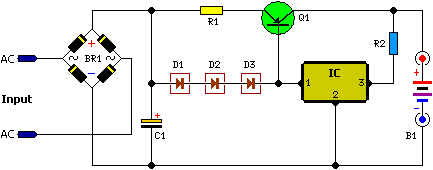Home » Circuits
12 Volt Car Battery Charger Circuit Schematic
Unlike many units, this battery charger continuously charges at maximum current, tapering off only near full battery voltage. In this unit, the full load current of the supply transformer/rectifier section was 4.4A. It tapers off to 4A at 13.5V, 3A at 14.0V, 2A at 14.5V and 0A at 15.0V.
Circuit operation:
Transistor Q1, diodes D1-D3 and resistor R1 form a simple constant current source. R1 effectively sets the current through Q1 - the voltage across this resistor plus Q1's emitter-base voltage is equal to the voltage across D1-D3. Assuming 0.7V across each diode and across Q1's base-emitter junction, the current through R1 is approximately 1.4/0.34 = 4.1A. IC ensures that Q1 (and thus the constant current source) is turned on.
When the battery has fully charged, the current through IC drops to a very low value and so Q1 turns off (since there is no longer any base-emitter current). R2 limits the current through IC. It allows enough current to flow through the regulator so that Q1 is fully on for battery voltages up to about 13.5V. Decreasing the value of R2 effectively increases the final battery voltage by raising the current cutoff point. Conversely, a diode in series with one of the battery leads will reduce the fully-charged voltage by about 0.7V.
Circuit diagram:
Parts:
Resistors
R1 = 0.32R
R2 = 8.2R
Capacitors
C1 = 10,000uF - 63V
Semiconductors
D1 = 1N4004
D2 = 1N4004
D3 = 1N4004
Q1 = MJ1504
IC = 7815 REG
BR1 = 1N4004x4
Miscellaneous
B1 = 12 Volt Battery
Notes:
- Charger's input voltages are 20 volt AC
- R1 and R2 are high wattage resistor like 2W, 3W, 5W and could be above. Select wattage on your choice.
- Q1 and IC requires a good heatsink. If they are mounted on the same heatsink and will throttle the circuit back if Q1 gets too hot.

